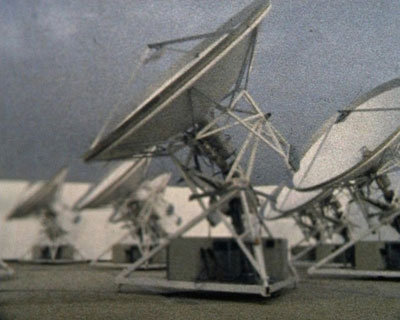![]()
![]()
![]()
![]()
...
...
.....
...
...
...
...
CERN
Flusser
Lord's Bridge
Lightning
Field
Ami,
still from Super 8 film, 2005
[Image
| Tim O'Riley]
The Mullard Radio Astronomy Observatory (MRAO) is sited at Lord’s Bridge which takes its name from an old railway station located 5 miles west of Cambridge.
While some of the telescopes date back to the 1950s and 60s, the Arcminute Microkelvin Imager, or AMI, is the most recent addition to the MRAO's roster of instruments. Its small array consists of ten 3.7 metre parabolic antennae housed in an enclosure with banked, aluminium walls to protect them from interference. The AMI small array is used in conjunction with the AMI large array, an upgraded version of the Ryle telescope, originally built in 1971. Together these dishes detect radiation from the Cosmic Microwave Background (CMB) which they use as a back light to reveal distant clusters of galaxies - the largest structures in our universe.
The CMB is regarded as evidence of the universe’s origin in the so-called big bang. One of the oldest cosmic artefacts, it is a field of electromagnetic radiation said to suffuse the entire universe. According to the big bang model, the universe in its infancy was intensely hot. It was filled with a plasma of charged particles and saturated with radiated energy left over from the big bang itself. Within this primordial maelstrom, energy and matter interacted such that they were impossible to differentiate.
The photons (which now comprise the CMB) scattered off free electrons and nuclei until about 380,000 years after the big bang, when the universe had expanded and cooled sufficiently to allow these free particles to combine to form hydrogen atoms (with which the CMB photons interacted weakly). From this point onwards, electromagnetic radiation was more or less free to flood the cosmos and provides evidence of the universe’s structure.
The early universe remains effectively opaque to contemporary observers as a result of this primordial scattering. It is like an obscuring cloud whose limits can be imagined as a hypothetical sphere in space-time. This sphere is designated by cosmologists as the 'surface of last scattering'. It represents the limit of the observable universe, the cosmological horizon.
Where the early universe was unimaginably hot, the CMB is now very cold. Its current temperature is 2.725° above absolute zero (0 Kelvin or -273.15 °C), the point at which matter contains no heat energy. There are tiny fluctuations in its structure which cosmologists and astrophysicists study to illuminate the origins, expansion and density of the universe and to understand the shape of space.
![]()
![]()
